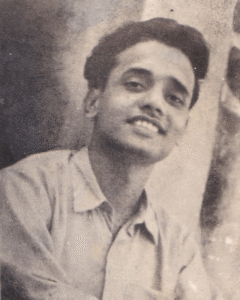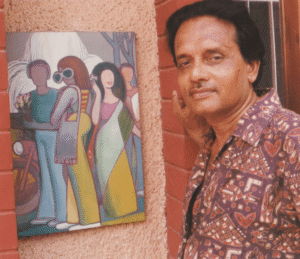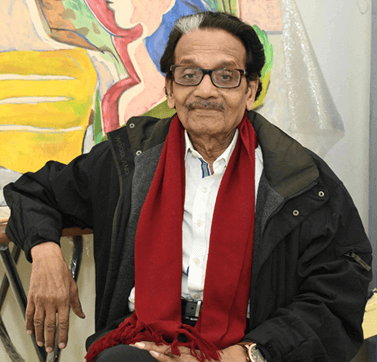Pratap Deb: Art Rooted in Life and Expression
By Dr. Ved Prakash Bhardwaj
 Pratap Deb’s artistic journey is a story of dedication, sensitivity, and diversified painting styles. From his college days at the Government College of Art and Craft, Kolkata, where he consistently topped his class, his passion for art was evident. His peers, including renowned artists like Ganesh Haloi, Sarbari Roy Chowdhury and Sakti Burman, described him as exceptionally talented and deeply committed.
Pratap Deb’s artistic journey is a story of dedication, sensitivity, and diversified painting styles. From his college days at the Government College of Art and Craft, Kolkata, where he consistently topped his class, his passion for art was evident. His peers, including renowned artists like Ganesh Haloi, Sarbari Roy Chowdhury and Sakti Burman, described him as exceptionally talented and deeply committed.
Pratap began his career in advertising with JWT, a leading agency, in 1956. Later, he joined the Mass Communication and Design Department of the Government of India, designing pan India campaigns such as “Jai Jawan Jai Kisan” and “Hum Do Hamare Do” which are landmarks in the history of this nation. His training in Applied Arts helped him combine creativity with effective public messaging. Despite his professional commitments, Pratap continued painting, often sketching or working in watercolour and pastels. During his visit to USA, his ink pen sketches captured people’s life in the country sides and universities. His time in Manila inspired a series capturing vibrant street life—scenes of joy, music, and youth that reflected his sensitivity to local culture.
 Although successful in commercial and government roles, Deb’s heart remained with fine art. After his retirement, Pratap dedicated himself fully to painting. He embarked on his journey as an Artist, painting varied styles, at the Lalit Kala Akademi’s Garhi studio in New Delhi. His artistic influences were broad—ranging from Rabindranath Tagore’s poetry and Rabindra Sangeet to Western masters like Picasso. Yet, he believed that true artistic influence lies in adapting style to one’s own time and society. While his work sometimes echoed Cubism, particularly in fragmented forms and perspectives, he never imitated; instead, he used such tools to deepen his own visual language.
Although successful in commercial and government roles, Deb’s heart remained with fine art. After his retirement, Pratap dedicated himself fully to painting. He embarked on his journey as an Artist, painting varied styles, at the Lalit Kala Akademi’s Garhi studio in New Delhi. His artistic influences were broad—ranging from Rabindranath Tagore’s poetry and Rabindra Sangeet to Western masters like Picasso. Yet, he believed that true artistic influence lies in adapting style to one’s own time and society. While his work sometimes echoed Cubism, particularly in fragmented forms and perspectives, he never imitated; instead, he used such tools to deepen his own visual language.

His paintings often centred on the common people—rickshaw pullers, balloon sellers, flower vendors—figures he portrayed with dignity and complexity. Many works had an underlying social critique. In one, a nude woman is partially obscured by crosshatched pen lines and bold pink strokes, evoking the vulnerability and objectification of women. Another shows fragmented faces, symbolizing the duality of human nature and society’s fractured psyche.
He was honoured by the All India Fine Arts & Crafts Society (AIFACS) for his contribution to Art and was awarded by former President of India, Dr. Shankar Dayal Sharma.
Pratap’s technique evolved over time—from the academic structure of his early oil paintings to the freer, bolder brushwork of his later period. The rough textures and dynamic strokes in his mature works express the instability and contradictions of urban life. In paintings depicting rickshaw pullers, the exhaustion and imbalance are palpable; in one, a puller is nearly collapsing, the road beneath painted with raw, uneven strokes.
Even in still images, Pratap conveyed a sense of movement and mental activity. His characters—though frozen in time—seem to breathe, think, and exist beyond the frame. He captured not only scenes but also the emotional pulse of life.
Pratap Deb believed in living art, not just making it. His works reflect empathy, observation, and a strong sense of social reality. Bridging the worlds of commercial design and fine art, Western technique and Indian experience, his legacy lies in his ability to portray the dynamism, joy, and struggle of everyday people with honesty and artistic depth.